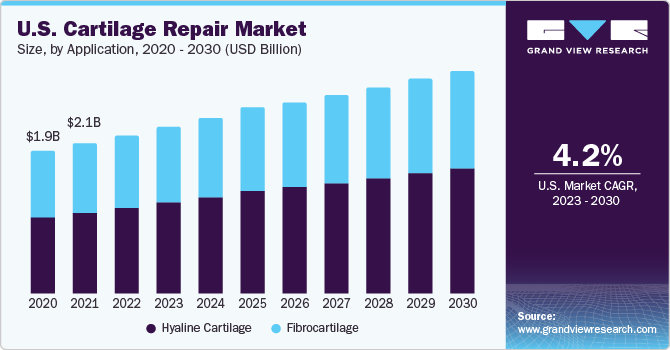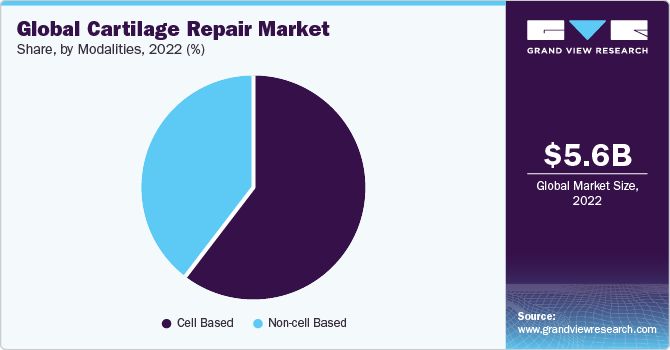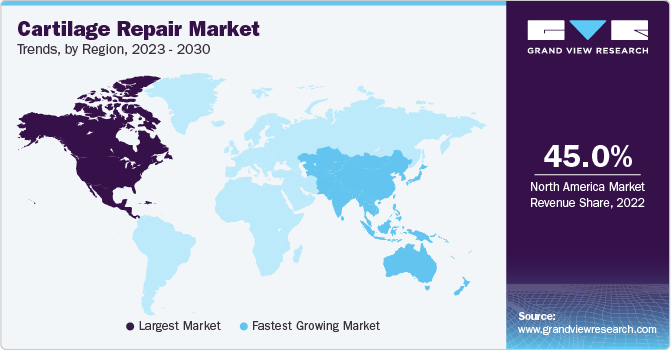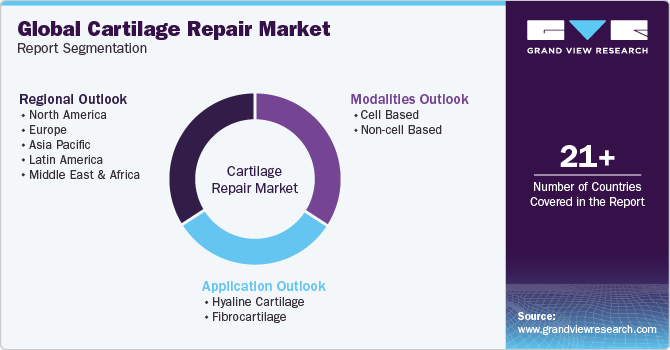- Home
- »
- Medical Devices
- »
-
Cartilage Repair Market Size, Share & Growth Report, 2030GVR Report cover
![Cartilage Repair Market Size, Share & Trends Report]()
Cartilage Repair Market Size, Share & Trends Analysis Report By Modality (Cell Based, Non-cell Based), By Application (Hyaline Cartilage, Fibrocartilage), By Region, And Segment Forecasts, 2023 - 2030
- Report ID: GVR-1-68038-922-7
- Number of Report Pages: 100
- Format: PDF, Horizon Databook
- Historical Range: 2018 - 2021
- Forecast Period: 2023 - 2030
- Industry: Healthcare
Cartilage Repair Market Size & Trends
The global cartilage repair market size was valued at USD 5.63 billion in 2022 and is anticipated to grow at a compound annual growth rate (CAGR) of 4.5% from 2023 to 2030. The global market is poised for growth driven by the increasing incidence of bone and joint disorders, such as Osteoarthritis (OA) or arthritis, as well as advancements in cartilage regeneration technology. The rising prevalence of OA can be attributed to factors such as the expanding geriatric population and the escalating impact of obesity and other related factors. According to the Centers for Disease Control and Prevention (CDC), in the U.S., approximately 34.2 billion people, or 10.5% of the population, have diabetes. Furthermore, adopting smart devices and technological advancements such as AI & data analytics are propelling the market growth.

The growth of the global cartilage repair industry is expected to be driven by the increasing incidence of diabetes and obesity worldwide. Diabetes is associated with heightened cartilage loss, while the rise in obesity, particularly in Latin America and the MEA region, is anticipated to drive the demand for cartilage repair products. For instance, the American Heart Association (AHA) estimated that the global geriatric population will comprise around 40.0% of the total population by 2030. This demographic, prone to chronic diseases, is expected to play a vital role in driving the demand for cartilage repair procedures and fueling market growth.
Various factors are driving the knee surgery. These include the increasing elderly population, investments in research and development activities, the growing preference for minimally invasive procedures, rising road accidents and sports-related injuries, and the growing concerns about obesity-related cartilage loss. However, certain challenges could hinder market growth, such as the high cost of knee cartilage repair surgeries and treatments, complications associated with these procedures among the elderly population, and the limited availability of cartilage-based stem cell products. On the other hand, the market presents opportunities with advancements in technology and knee cartilage repair techniques, particularly in the Asia Pacific region. Nonetheless, stringent government regulations may pose challenges to the growth of the market.
The surge in road accidents and sports-related injuries globally is set to contribute to the demand for cartilage repair products. According to the World Health Organization (WHO) report, approximately 1.35 million people succumb to road accidents yearly, further underscoring the need for effective cartilage repair solutions. In the U.S., the participation of around 60.0 million children and adolescents in youth sports annually leads to an increased incidence of injuries among athletes, with 27.0% of injuries involved in one sport, according to the National Council of Youth Sports. These factors collectively contribute to the growth prospects of the market and are expected to drive its expansion in the foreseeable future.
The COVID-19 pandemic has reduced the volume of knee cartilage repair surgeries, as these procedures are considered non-essential when compared to the urgent medical services required for COVID-19 patients. The impact of COVID-19 on the knee cartilage repair market is becoming increasingly evident, with various factors contributing to its decline. Indirect influences include factors such as flight cancellations, travel bans, widespread quarantine measures, heightened public anxiety, and uncertainty about the future. These circumstances have resulted in a decrease in medical aesthetics procedures and a decline in the adoption of knee cartilage repair treatments.
Modalities Insights
The cell-based modalities segment held the largest market share of over 60% in 2022 and is expected to grow at the fastest rate of 5.0% during the forecast period. The primary modalities examined are cell-based and non-cell-based approaches. This growth is attributed to the growing preference for autologous chondrocyte transplants as a surgical treatment for damaged articular cartilage, including chondral and osteochondral lesions. It is expected to be a significant driver for market growth. This increasing preference is projected to fuel the expansion of the market.

According to the Arthritis Foundation, around 32.5 million adults in the U.S. have been diagnosed by a doctor with osteoarthritis. It is anticipated that this number is expected to rise to 43 million by the year 2040. Osteoarthritis is a condition where the cartilage in joints deteriorates, causing pain, stiffness, and reduced mobility. The non-cell-based segment is further categorized into tissue scaffolds and cell-free composites. Tissue scaffolds have the ability to promote the growth of cartilage and bone when transplanted into joints, particularly in the knees. As a result, they are more extensively utilized compared to cell-free composites.
Application Insights
The application segment of the industry comprises hyaline and fibrocartilage. The hyaline cartilage segment held a significant market share in 2022. This is attributed to the increasing occurrence of physical trauma worldwide, which can result in osteochondral and chondral lesions in patients. The world is becoming increasingly urbanized, and this is leading to an increase in the number of people who are exposed to risk factors for trauma, such as traffic accidents and violence. According to the National Center for Biotechnology Information (NCBI), trauma significantly contributes to mortality and disability in the U.S. Among individuals under the age of 45, trauma is responsible for approximately 79,000 deaths annually, surpassing both non-communicable disease and infectious disease-related deaths. For individuals under the age of 65, trauma is the primary cause of potential years of life loss.
The fibrocartilage segment is expected to grow at a significant CAGR over the forecast period, primarily due to the patients increasingly seeking minimally invasive procedures for cartilage repair. These procedures are associated with a shorter recovery time and a lower risk of complications than traditional surgical procedures.
Regional Insights
North America was the largest market for cartilage repair, with a share of over 45% in 2022, and is expected to continue its dominance during the forecast period. The growth of the market in the U.S. and Canada can be attributed to factors such as the increasing prevalence of musculoskeletal diseases, the presence of a target population, and changes in individuals' lifestyles. In addition, the rising prevalence of osteoporosis in countries such as the UK, Germany, and France is expected to have a significant contribution to the market in Europe. Every year, approximately 500,000 individuals require hospital treatment for fragility fractures, which are fractures occurring from standing height or less because of osteoporosis.
According to the United States Bone and Joint Initiative, Musculoskeletal diseases impact over 50% of individuals aged 18 and above in the U.S., and the prevalence increases to nearly 75% for those aged 65 and over. The most frequently reported musculoskeletal conditions are trauma, back pain, and arthritis, resulting in numerous healthcare visits to physicians' offices, emergency departments, and hospitals annually. Musculoskeletal diseases have a notably higher occurrence than circulatory and respiratory diseases, with most cases involving treatable conditions such as chronic hypertension, hay fever, and bronchitis.

Asia Pacific is predicted to grow at the fastest CAGR of 5.8% during the forecast period. In Asia-Pacific, hip and knee replacement and surgeries are among the most performed and effective procedures. The Asia-Pacific knee segment in the market is anticipated to grow due to increased knee disorders and the growing geriatric population. Factors such as the rising risk of osteoporosis-related fractures and accidents also contribute to the market's growth. Additionally, market players' initiatives to launch advanced products in the region further boost market growth. Osteoarthritis is the primary indication for these surgeries, as it often leads to cartilage damage and the destruction of articular cartilage.
Moreover, Asia Pacific is experiencing a surge in knee surgeries, primarily attributed to the treatment of osteoarthritis, which involves cartilage repair procedures. Furthermore, the region is witnessing an increasing prevalence of sports-related knee injuries, as well as expanding indications for total knee replacement driven by the preferences of both patients and surgeons. These factors collectively contribute to the growing number of knee surgeries in the Asia Pacific.
According to the report from Osteoporosis Australia, osteoporosis and osteopenia are significant public health problems in Australia. In 2022, it was estimated that 4.74 million Australians over the age of 50 had osteoporosis or osteopenia and that these conditions accounted for 1.8 million disability-adjusted life years (DALYs). DALYs are a measure of the overall burden of disease, taking into account both mortality and disability. The report also found that the burden of osteoporosis and osteopenia is expected to increase. This is due to the aging population, as well as the increasing prevalence of obesity, which is a risk factor for osteoporosis. Overall, the Asia-Pacific knee cartilage repair segment in the market is poised for growth, driven by various factors and challenges and opportunities in individual countries within the region.
Competitive Insights
The market is dominated by the number of manufacturers accounting for most of the market share. Product launches, approvals, strategic acquisitions, and innovations are just a few of the important business strategies market participants use to maintain and grow their global reach. For instance, in June 2019, Smith & Nephew completed the acquisition of Osiris Therapeutics, Inc. The merger and acquisition benefited Smith & Nephew as Osiris was a rapidly growing company that offered regenerative medicine products such as articular cartilage substitutes, bone graft, and skin. The acquisition was expected to help the company grow for the Advanced Wound Management franchise of Smith & Nephew. The following are some of the major participants in the global cartilage repair market:
-
Zimmer Biomet
-
Stryker
-
Collagen Solutions (US) LLC
-
BD (Becton, Dickinson and Company)
-
Arthrex, Inc.
-
Anika Therapeutics, Inc.
-
B. Braun SE
-
Smith+Nephew
-
Vericel Corporation
-
Johnson & Johnson Services, Inc.
-
Medcata International
Cartilage Repair Market Report Scope
Report Attribute
Details
Market size value in 2023
USD 5.95 billion
Revenue forecast in 2030
USD 8.08 billion
Growth rate
CAGR of 4.5% from 2023 to 2030
Base year for estimation
2022
Historical data
2018 - 2021
Forecast period
2023 - 2030
Report updated
October 2023
Quantitative units
Revenue in USD billion, and CAGR from 2023 to 2030
Report coverage
Revenue forecast, company ranking, competitive landscape, growth factors, and trends
Segments covered
Modalities, application, region
Regional scope
North America; Europe; Asia Pacific; Latin America; & MEA
Country scope
U.S.; Canada; UK; Germany; France; Italy; Spain; Denmark; Sweden; Norway;, Japan; China; India; Australia; South Korea; Thailand; Brazil; Mexico; Argentina; South Africa; Saudi Arabia; UAE; Kuwait
Key companies profiled
Zimmer Biomet; Stryker; Collagen Solutions (US) LLC; BD (Becton, Dickinson and Company); Arthrex, Inc.; Anika Therapeutics, Inc.; B. Braun SE; Smith+Nephew; Vericel Corporation; Johnson & Johnson Services, Inc.; Medcata International
Customization scope
Free report customization (equivalent to up to 8 analyst’s working days) with purchase. Addition or alteration to country, regional & segment scope
Pricing and purchase options
Avail customized purchase options to meet your exact research needs. Explore purchase options
Global Cartilage Repair Market Report Segmentation
This report forecasts revenue growth at global, regional, and country levels and provides an analysis of the latest industry trends in each of the sub-segments from 2018 to 2030. For the purpose of this study, Grand View Research has segmented the global cartilage repair market report on the basis of modality, application, and region:

-
Modalities Outlook (Revenue, USD Billion, 2018 - 2030)
-
Cell Based
-
Non-cell Based
-
-
Application Outlook (Revenue, USD Billion, 2018 - 2030)
-
Hyaline Cartilage
-
Fibrocartilage
-
-
Regional Outlook (Revenue, USD Billion, 2018 - 2030)
-
North America
-
U.S.
-
Canada
-
-
Europe
-
UK
-
Germany
-
France
-
Italy
-
Spain
-
Denmark
-
Sweden
-
Norway
-
-
Asia Pacific
-
Japan
-
China
-
India
-
Australia
-
Thailand
-
South Korea
-
-
Latin America
-
Brazil
-
Mexico
-
Argentina
-
-
Middle East and Africa
-
South Africa
-
Saudi Arabia
-
UAE
-
Kuwait
-
-
Frequently Asked Questions About This Report
b. The global cartilage repair market size was estimated at USD 5.63 billion in 2022 and is expected to reach USD 5.95 billion in 2023.
b. The global cartilage repair market is expected to grow at a compound annual growth rate of 4.5% from 2023 to 2030 to reach USD 8.08 billion by 2030.
b. Cell-based dominated the cartilage repair market with a share of 60.5% in 2022. This is attributable to the increasing preference for autologous chondrocyte transplants for surgical treatment of damaged articular cartilage.
b. Some key players operating in the cartilage repair market include Zimmer Biomet; Stryker Corporation; DePuy Synthes; Smith & Nephew plc; Vericel Corporation; Osiris Therapeutics Inc.; B. Braun Melsungen AG; Anika Therapeutics, Inc.; Arthrex, Inc.; and Collagen Solutions Plc.
b. Key factors that are driving the market growth include rising prevalence of bone and joint disorders, such as Osteoarthritis (OA) or arthritis, and technological advancements in cartilage regeneration.
Share this report with your colleague or friend.
![gvr icn]()
NEED A CUSTOM REPORT?
We can customize every report - free of charge - including purchasing stand-alone sections or country-level reports, as well as offer affordable discounts for start-ups & universities. Contact us now
![Certified Icon]()
We are GDPR and CCPA compliant! Your transaction & personal information is safe and secure. For more details, please read our privacy policy.
We are committed towards customer satisfaction, and quality service.
"The quality of research they have done for us has been excellent."





